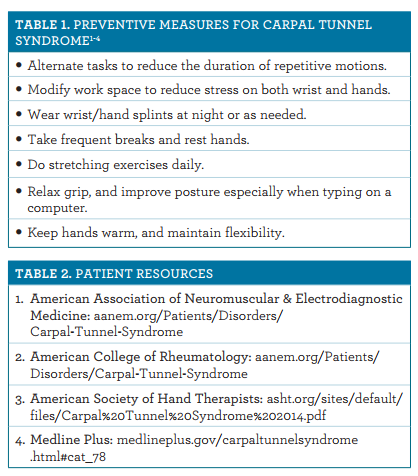Publication
Article
Pharmacy Times
Getting a Grip on Carpal Tunnel Syndrome
Author(s):
Carpal tunnel syndrome is a common and progressive neurologic condition caused by the compression and irritation of the median nerve in the wrist, leading to varying degrees of pain and weakness in the wrist or hand.
Carpal tunnel syndrome is a common and progressive neurologic condition caused by the compression and irritation of the median nerve in the wrist, leading to varying degrees of pain and weakness in the wrist or hand.1-5 The carpal tunnel is a narrow, rigid passageway of ligaments and bones at the base of the hand that encompasses the median nerve and the tendons that bend the fingers.1 The median nerve is responsible for both sensation and movement in the hand, principally in the thumb, index finger, and 2 middle fingers.1,2 According to the American College of Rheumatology, carpal tunnel syndrome affects an estimated 4 million to 10 million Americans, primarily middle-aged to older individuals, and occurs 3 times more frequently in females than in males.2 Additionally, carpal tunnel syndrome is perceived as the most common nerve disorder.2 Although carpal tunnel syndrome may occur at any age, it typically presents between 45 and 54, with the risk increasing for both men and women as they age.3 Carpal tunnel syndrome is responsible for work absences and lost productivity, and the US Department of Labor reported in 2015 that the average annual number of missed work days due to the condition was 28.3
Pharmacists are likely to encounter patients seeking counsel about carpal tunnel syndrome, especially regarding self-management and the available nonprescription products that may help treat and manage the condition, such as analgesics and protective and supportive hand/wrist splints.

If left untreated, carpal tunnel syndrome can eventually lead to complete, irreversible median nerve damage, accompanied by a severe loss of hand function.1-5 Various factors have been identified as possibly causing or exacerbating carpal tunnel syndrome, and these factors may increase pressure on the median nerve and tendons in the carpal tunnel.1-5 Results from a 2017 study showed that there may be a correlation between the extended use of smartphones and other handheld electronic devices and the development of carpal tunnel syndrome, but further study is warranted.6 Risk factors associated with the development of carpal tunnel syndrome may include:1-5
- Increasing age
- Fluid retention during pregnancy or menopause
- Being overweight
- Family history, including multiple inherited characteristics such as square wrists, thickened transverse ligament, and stature
- Having various medical conditions such as rheumatoid arthritis, hypothyroidism, diabetes, arthritis, and lupus • Injuries such as wrist fractures or trauma to the wrist
- Work or activities that require repetitive motions of the hands and wrist
- Exposure to excessive vibration movements and/or cold
- Prolonged, severe force through the wrist
- Acromegaly
- Amyloidosis

SIGNS AND SYMPTOMS
Carpal tunnel syndrome presents itself in varying degrees and may range from mild to severe. Frequently, symptoms manifest first thing in the morning, but they can occur anytime, even during the night, disrupting sleep and causing insomnia.1-5 The primary symptoms associated with carpal tunnel syndrome include tingling and/or numbness in the fingers and/or hand, especially in the thumb, index finger, and middle finger.1-5 Symptoms may be bilateral, though the dominant hand is typically affected first,with more severe symptoms.5 The symptoms tend to develop and worsen over time and are usually intermittent and associated with certain activities such as driving, crocheting, painting, writing, and working on electronic devices.4 Other signs and symptoms include:1-5
- Numbness and tingling of fingers and hands
- Weakness or decreased grip strength
- “Pins and needles” sensation in the hand
- Stiffness in the fingers upon waking
- Difficulty feeling and handling small objects
- Loss of grip or dropping things
- Occasional aching pain in the forearm between the elbow and wrist
- Swelling in the hand or wrist
TREATMENT AND CARE
In February 2016, the American Academy of Orthopedic Surgeons released evidence-based clinical practice guidelines on the management of carpal tunnel syndrome, which include testing and recommended therapies. These guidelines can be found at aaos.org/ uploadedFiles/PreProduction/Quality/Guidelines_and_Reviews/ guidelines/CTS%20CPG_2.29.16.pdf.
To minimize damage, treatment for carpal tunnel syndrome should be initiated as soon as a diagnosis is confirmed. An estimated 90% of mild to moderate cases of carpal tunnel syndrome respond to conservative therapy, while more severe cases may warrant physical therapy or surgery.4 Mild cases of carpal tunnel syndrome may be alleviated by taking frequent breaks from activities to rest hands, by using cold or ice packs to ease any swelling, and by avoiding activities that may worsen symptoms when possible. If no contraindications or drug interactions are present, the shortterm use of analgesics such as acetaminophen or nonsteroidal anti-inflammatory drugs may be used.1-5 Patients who take other medications and those with other medical conditions should check with their pharmacists or primary health care provider prior to taking any medication to ascertain appropriateness. There are also a host of hand/wrist splints that assist in keeping the wrist straight and stable, especially at night, and decrease pressure on the median nerve.1-5 Some people wear the splints during the day as well to keep the wrist in a stable position. Some studies suggest that the use of wrist splints may provide relief from symptoms in 70% of patients, but the relief is typically only temporary.7 In some cases, patients may be prescribed a corticosteroid injection or a diuretic to decrease swelling if warranted, or a primary health care provider may recommend a surgical procedure known as a carpal tunnel release.4 Results from a 2017 study show that physical therapy is as effective as surgery in treating carpal tunnel syndrome.8
Ms. Terrie is a clinical pharmacist and medical writer based in Haymarket, Virginia.
References
- Carpal tunnel syndrome fact sheet. National Institute of Neurological Disorders and Stroke website. ninds.nih.gov/Disorders/Patient-Caregiver-Education/Fact-Sheets/Carpal-Tunnel-Syndrome-Fact-Sheet. Accessed June 30, 2017.
- Carpal tunnel syndrome. American College of Rheumatology website. rheumatology.org/I-Am-A/Patient-Caregiver/Diseases-Conditions/Carpal-Tunnel-Syndrome. Updated March 2017. Accessed June 30, 2017.
- Womenshealth.gov. Carpal tunnel syndrome. womenshealth.gov/a-z-topics/carpal-tunnel-syndrome. The womenshealth.gov website. Updated April 28, 2017. Accessed June 30, 2017.
- Ashworth N. Carpal tunnel syndrome. Medscape. emedicine.medscape.com/article/327330-overview#a4. Updated April 19, 2017. Accessed June 30, 2017.
- Steinberg, D. Carpal tunnel syndrome. Merck Manual Professional Version. merckmanuals.com/professional/musculoskeletal-and-connective-tissue-disorders/hand-disorders/carpal-tunnel-syndrome. Published November 2016. Accessed June 30, 2017.
- Woo EHC, White P, Lai CWK. Effects of electronic device overuse by university students in relation to clinical status and anatomical variations of the median nerve and transverse carpal ligament. Muscle Nerve. June 21, 2017. doi: 10.1002/mus.25697.
- BMJ Best Practice. Carpal tunnel syndrome. BMJ Best Practice website. bestpractice.bmj.com/best-practice/pdf/patient-summaries/531940.pdf. Published February 14, 2017. Accessed June 30, 2017.
- Fernández-de-las-Peñas C, Cleland J, Palacios-Ceña M, Fuensalida-Novo S, Pareja JA, Alonso-Blanco C. The effectiveness of manual therapy versus surgery on self-reported function, cervical range of motion, and pinch grip force in carpal tunnel syndrome: a randomized clinical trial. J Orthop Sports Phys Ther. 2017;47(3):151-161. doi:10.2519/jospt.2017.7090.







